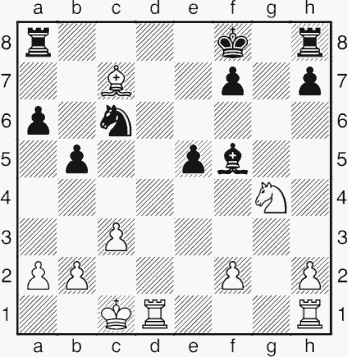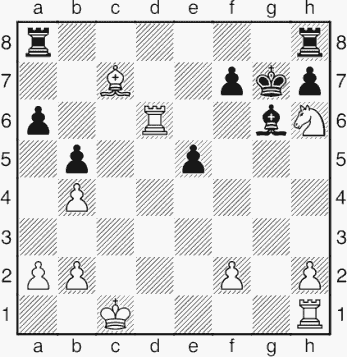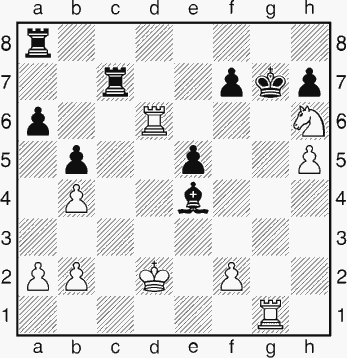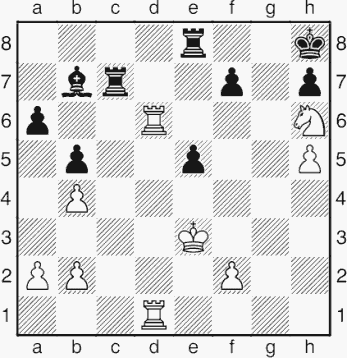
Almost all competitive chess, and quite a large proportion of social chess, is played with a time limit of some sort. In lightning chess the players must move every few seconds when a buzzer sounds, whereas even in the more sedate postal chess, with a few days per move, it is surprisingly common for players to lose a game by overstepping the time limit. There are countless ways of timing a chess game, including some that are rather bizarre. In The Silence of the Lambs, for example, there is a chess game played with a beetle clock – a live beetle walks from one side of the board to the other; when a player moves, he turns the beetle around and it trundles its way towards the opponent.
However, in the vast majority of games, the time limit is enforced by the use of a chess clock. Traditionally this consists of two standard clocks rigged up so that when one clock is stopped, the other starts, although digital clocks, performing the same function, are becoming increasingly common. When a player moves, he is entitled to stop his clock, so starting the opponent’s. Thus the times on the two clocks indicate how much time each player has used in total. When the minute hand is pointing vertically upwards (towards 12), a small “flag” falls. If this indicates that the player’s thinking time has elapsed, and he has not completed the specified number of moves, then he has lost the game of time.
The clock is the most important piece of chess equipment after the board and the set, and a good understanding of how to use it and negotiate the problems of playing under time pressure is essential to anyone wishing to play successful and enjoyable chess. This short chapter is devoted to these topics.
There are many rates of play in use. Here are the most common:
1. Blitz chess: five minutes for each player for all of the moves
This is an extremely popular time limit used by experienced players when playing for fun. There is little time for deep thought; reflexes and intuition count for much in blitz chess. Games often include blunders and are frequently lost on time. Nevertheless, five minutes is not a trivial amount of time, and five-minute games provide wonderful scope for chessboard opportunism. They can be used as a testing ground for ideas, and can be used to develop an understanding of a particular opening scheme – supposing you can find a like-minded opponent of similar strength to yourself, then you will learn a lot more from an hour of blitz games playing either side of an opening in which you are both interested, than you would from spending the same time reading up on it.
Opinions vary on whether blitz chess is good for your chess generally. Some feel that playing a lot of blitz chess leads to superficial thought-processes, and rushed decision-making. Others point to the increased tactical awareness that it engenders, and argue that the practice at making quick decisions is valuable when in time-trouble in longer games. I feel that for club players, it all depends on your style of play, and in particular whether you tend to play too slowly – if so, then some practice playing quickly might be a good idea.
There’s no consensus amongst World Champions on the matter either. Mikhail Botvinnik, an extremely serious man, would never sit down to play a game unless deeply prepared, and never played for fun. There is a story that when the elderly Botvinnik was asked by a young player whether he fancied a five-minute game, his response was that he hadn’t played a game of blitz chess for more than fifty years!
On the other hand, Mikhail Tal, charismatic genius and brilliant tactician, would play anyone, anytime, anywhere at blitz chess. He didn’t care; he just loved playing chess. In his final weeks, in the grips of his final illness, he would still play many blitz games each day – and to a high standard too.
In some large cities, one can find people willing to play chess in the open air – generally in parks – for money; generally a modest amount per game. The standard time limit in these games is five minutes for all the moves. It is not unknown for strong players, even of international calibre, expecting to make an easy profit from these hustlers, to get a nasty shock – although they may not be such strong players, their specialism in the five-minute variety of the game can more than compensate for this.
Five minutes is by no means the shortest possible time limit. Three minutes is quite common, while some speed demons try to play entire games in two or even one minute. I must confess to being rather partial to one-minute chess, but could hardly deny that these games have little to do with chess. Still, it’s an excellent way to demonstrate, for example at parties, that chess is by no means a slow, boring game!
2. Rapidplay: 20, 30 or 40 minutes for all the moves
The chess played at these time limits resembles “real chess” far more. There is time to make proper plans, to avoid blunders and to calculate tactical sequences, rather than relying so heavily on intuition.
These time limits are often used in one-day “quickplay” tournaments; generally six games in one day. These are popular with players and organizers, since there is no need to find overnight accommodation – one of the drawbacks of the traditional two- or three-day weekend tournaments.
Rapidplay may also have a future on television. Intel’s series of Grand Prix events brought together the world’s top players, battling it out for big money in rapid games. The games made for plenty of excitement and entertained live audiences – ready-made for television. Some of the games were decided by great chess, and others by hideous blunders.
3. Local league and weekend chess: typically 35 moves in 75 minutes
Local leagues are generally played in the evenings. Considering that players have to travel to and from the venue, this tends to leave little more than three hours for playing the game. A typical time limit is an hour and a quarter, or an hour and a half, for the first 30 or 35 moves. What happens after those moves varies from league to league, often depending on agreement between the players or the captains. One option, an increasingly popular one, is a blitz finish: an extra 15 or 20 minutes is added to both players’ clocks and the game played to a finish – the main drawback being that blunders often decide the game, and local league players then never get a chance to play an ending when they have plenty of time to think. Another possibility is adjudication, but this has always been regarded as a bad way to finish a game – a game should be won by beating the opponent, not by impressing an unseen adjudicator into awarding a full point. In the past, adjourning the game and playing on at a later date was the best option, provided both players found it convenient. However, nowadays upon resumption the result might be determined largely by which player has the more powerful computer on which to analyse the position.
This sort of time limit is also used for weekend tournaments, in which five or six games are played over a weekend: perhaps one game on Friday evening, two or three on Saturday, and two on Sunday. Clearly with such a rough schedule as this, four hours is a sensible maximum length per game.
4. International chess: 40 moves in 2 hours
This is the standard time control in international events. It may sound slow, but for a tough game between two evenly matched experts, it can go very quickly. The players then have a time increment per move and/or an extra hour each to reach move 60. By that point most games are finished, but for those that are not, some sort of quickplay finish is the norm.
Electronic chess clocks are becoming increasingly used in chess competitions, so it is well worth acquainting yourself with them. A good example is the Digital Game Timer (DGT 2010 is the current model), which has been endorsed by FIDE, and costs about �60 (c. $100). It is much lighter than a traditional clock, runs off batteries, and features two digital clock displays and various buttons, together with the traditional bar on top. It can time many different modes of play, including: standard blitz or quickplay (all the moves in a certain amount of time); “gong” mode for lightning chess; “Fischer” time controls (in which a certain amount of time is added every time a move is played); and tournament time limits, with several time controls followed by a quickplay finish. I would recommend that competitive players study the instruction book carefully, as there are several sources of confusion related to the use of the clock.
These tips assume that you are playing competitive chess. If you are just playing informally with a friend, then obviously feel free to do as you please, except that I suggest it is good practice to get into the habit of using the clock properly.
1. Never forget to press your clock after you have moved!
This may seem obvious, but at all levels of chess-playing, precious minutes are squandered by players forgetting to press their clock. Even Anatoly Karpov, one of the greatest players of all time, made this fatal error in a critical world championship game against Garry Kasparov. If your opponent forgets to press his clock, you should feel under no compulsion to tell them. It’s their fault – enjoy the free time!
2. Don’t forget to check whether your opponent has lost on time
Under many circumstances, the onus is firmly on the player to point out that the opponent has lost on time. Neither spectators nor team captains have any right to do so.
3. Press the clock with the same hand with which you have moved the piece
This is one of the laws of chess, and a player can be warned or penalized for breaking the rule. The reason is clear: otherwise both players could, in a time scramble, have one hand on the clock and the other moving the pieces. The time recorded for each player would have little to do with the time taken for each move.
4. Do not abuse the clock by hitting it too hard
Some players really bash the clock, but this is totally unnecessary. A chess clock is a sensitive device, so hitting it too hard might cause a malfunction. You could also be reprimanded, especially if the clock belongs to the arbiter!
5. If the clock is malfunctioning, draw attention to this immediately, and not after the game
A clock that is running too fast or slow, or has a flag that falls too early, can be replaced, but do not expect the game to be replayed if you make your claim after losing on time!
6. Never pick up the clock
This is completely against the rules and can even result in forfeit of the game.
7. Never stop both clocks without a very good reason
Stopping both clocks without making a move is a way of resigning, and may well be interpreted as such. There are certain circumstances under which the clocks can be stopped, but only do so if you are certain you are entitled to do so, or if an arbiter gives permission.
8. Make sure you know the time limit before you start play!
This sounds extremely obvious, but there are instances of players losing on time without even realizing it!
9. Don’t get into time-trouble!
Let’s face it, there’s no need to get into time-trouble, and while it is sensible to make good use of your clock time, it never does any harm to keep a little in reserve. If you realize you are day-dreaming at the board, or spending a lot of time on an interesting idea that you’re sure you won’t end up playing, a little self-discipline is required: make a reasonable move, and get on with the game.
10. Keep score carefully
Write down each move, as it is played, neatly on your scoresheet. What does this have to do with the clock? There are instances of players believing they have made the time control, only to find upon deciphering the scribble on their scoresheet, that they skipped a move, and so have lost on time.
Here’s an example of two top-class GMs playing in time-trouble. It’s surprising how some really good moves are played. The fact that they are mixed in with a few blunders is to be expected.
Shirov – Gelfand
Wijk aan Zee 1996

With both players in time-trouble, Shirov found a good move:
30 Nh6!
Either capture on e5 would give Black time to activate his rook on the g-file, with good drawing chances. Moreover, Black’s moves to reach the time-control would then be easy ones.
30...Bg6
30...Be6 31 Rhg1 takes the rook off h1, making Rd6 an unpleasant threat.
31 Rd6 Nb4!
An excellent time-trouble move, especially given that Black does not have much to lose. It would be very easy to White to go to pieces totally with just a few minutes – or even worse seconds – to decide on a reply to such a move. Instead 31...Ne7 32 Rd7 is simply good for White – with easy moves.
32 cxb4
Taking the knight is best. If White had been bluffed into not taking, then Black would have been quite OK.
32...Kg7
Now what does White do? Very few players would be able to find the right continuation in such circumstances.

33 h4!
Shirov analysed two alternatives as giving no winning chances:
a) 33 Nxf7 Kxf7 34 Rhd1 Rhc8 35 Rd7+ Ke8 and Black draws.
b) 33 Ng4 Rhc8 34 Rc6 (34 Nxe5? Rxc7+ 35 Kd1 Rac8 36 Re1 Rc1+ 37 Ke2 Rxe1+ 38 Kxe1 Re8 39 f4 f6 picks off the knight) 34...Be4 35 Bxe5+ Kf8 36 Bd6+ Kg7 37 Be5+ is a draw by repetition.
33...Rhc8
33...Kxh6 34 h5 wins the bishop while denying Black time to retaliate by rounding up the white bishop.
34 h5!
34 Rc6 f6! is equal; Black ensures that Bxe5 will not be check, and will win back one of White’s minor pieces.
34...Rxc7+ 35 Kd2 Be4 36 Rg1+

Gelfand has won back his piece, but Shirov has seen that his attack is now very strong, thanks to his h-pawn covering the g6-square.
36...Kh8
White can cope with 36...Kf8 37 Rg8+ Ke7 38 Rxa8: 38...Kxd6 39 Rxa6+ should be an endgame win for White; 38...Bxa8 39 Nf5+ Ke8 40 Rxa6 is very good for White.
37 Ke3
Hounding the bishop yet more to give White’s pieces more squares.
37...Bb7 38 Rgd1!
A good sensible move. “Here I spent a couple of minutes trying to take full advantage of the mating net, but not finding anything special I had to make a move to avoid losing on time.” (Shirov).
38...Re8?
38...Rf8 39 Nf5 is good for White, but the move played is worse.

39 Nf5?
39 Rd7 wins – it may seem odd that having seen such complicated tactics, Shirov should miss such a simple win of material, but sometimes the mind works that way in time-trouble...
39...Bc8??
This really is a time-trouble blunder. With anything more than a handful of seconds, Gelfand would undoubtedly have played 39...Rc4!, e.g. 40 f3 Rf4 41 Rd8 Rxf3+ 42 Ke2 Rxf5 43 Rxe8+ Kg7 44 Rg1+ Kh6 45 Rf1 and although Shirov thinks that White should win, the game continues.
40 Rd8 Bxf5 41 Rxe8+ Kg7 42 Rxe5 1-0